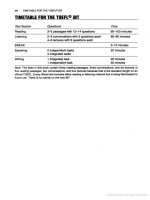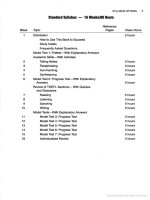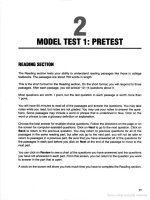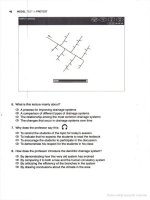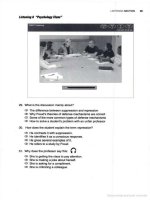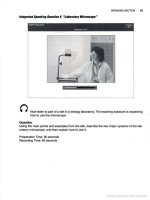Toefl ibt internet based test 2006 - 2007 part 2 pptx
Bạn đang xem bản rút gọn của tài liệu. Xem và tải ngay bản đầy đủ của tài liệu tại đây (938.48 KB, 7 trang )
lliv
TIMETABLE
FOR
THE
TOEFL
- lilT
TIMETABLE
FOR
THE
TOEFL
ill)
IBT
Test
Section
Questions
r"""
Reading
3-5
passages with 12- 14 questions
60-100
minutes
USlening
2-3
COJlV8fS8.tions
with 5 questlons each
60-00
minutes
4-6
lectures with 6 questlons each
BREAK
5-1
0 minutes
Speaking
2
independent
tasI<s
20 minutes
4 integrated tasks
Writing 1 Integrated task 20 minutes
1
independent task 30 minutes
Nole: The tests in
this
book contain three reading passages, three oom8lsations, and six lectures
or
five reading passages,
two
conversations, and
low
Iec:tures
because that is the
standard
length lor an
official TOEFL. Every
official
les! includes either reading
or
listening material that Is being fle.ld.tested
!of
future use. There is
no
tutorial
on
the
new
IBT.
'",
,~""ttel
mater.ale
TO
THE
STUDENT:
HOW
TO
USE
THIS
BOOK
TO
SUCCEED
A
STUDY
PlAII
Many students do not prepare for
the
TOEFL before they take
the
exam. They
do
not
even
read
the
TO
E
FL
e
/B
T
Information
and
Registration
Bulletin
when they register. You have an
advantage. Using this
book
,
you
have a study plan
for
success.
STEPS
TO
SUCCESS
This
book
Is
easy to use.
Mote
than one million Barron's students have succeeded on the
TOEFL.
You
C8Il
be
successful too,
by
following twelve steps.
, 1.
Inform
YOUl"lltf
about
the
tnt.
Aead
the
answers to "FAQs- Frequently Asked Questions
Aboullhe
TOEFL. ter In this
chapl
ef.
Then, if you cannot find a copy locally, visit the TOEFL web site at _
.et
orgItoefl
to
download a
copy
01
the
TOEFL
Inronnation
and
Registration
Bu/letin
.
Research
demon-
strates that students
who
know
what
to
81lpect
wi
ll perlorm better
on
an
examination.
,
2.
Imat
time
I.
your
shut,
plln.
Be
roaJlsllc about
how
mueh tlmo you
neod
to
propene for
the
TOEFL. Choo&e
III
syllabus from
the
choices
In
this chapter.
Use
distributed
practice-two
hours every
day
!of
lour
months will
give
you
better results
than
twetve
hours
every day
for
forty
days, even though
you
will
be
studying 1
20
hours
for
both schedules.
~
3.
Develop
study habits.
The
study habits explained at
the
end of this chapter will help
you
succeed
on
the TOEFL
and
after
!he
TO
EFL
when
you
are admitted
10
a college or university, or when
you
conti
nue
your
professional
training to
keep
your
licenses current. Successful students understand the value
of these habits.
,
2 ORIENTATION
4.
EYaluate
Jour
strnttM
and
weaknesses.
Take
the
Pretest, Model Test 1
in
Chapter 2
and
check
your
answers using the Explanatory
or
Examp
le Answers
and
Aud
io
Scripts
for Model Tests in
Chapter
7. Which sections
01
the
TOEFL
were easier
for
you?
Wh
ich were more difficult? Plan
to
spend
more
l
ime
on
the
sec-
lions
on
which
you received
lower
scores •
5.
Master
academic
skllts.
Chapter
3 contai
ns
a summary of
the
academic skills that you will
need
to
complele
lhe
tasks
on
the
Next
Generation T
OEFl.
Read
lhe
stralegies. complete !he practice activities, and
check your answers.
By
going
sys
tematically through this chapter, you will acquire valuable
academic skills.
Take
your
time
and
learn !hem well .
6.
Check
Jour
progress.
Alter you finish
the
work in
Chapter
3, you will
be
ready
10
checlt your progress. Take the
firs1
Prog
ress Test, Model Test 2 in Chapter 4
and
check your answers using
the
Explanatory
or
Example Answers in Chapter 7.
You
should begin
to
see how the academic skills are used
on
the new T
OEFL
* i
8T
.
,
7.
Improwe
English
proficlellCJ.
Chapter 5 will show you
how
your
English profiCiency is tested
on
!he
TOEF
L.
Review
Impor·
tantlanguage
problems and identify strategies
for
the language skill that corresponds
to
each
section-Reading,
listening
,
Speaking,
and
Writing. Take t
he
quizzes
and
chec
k
your
answers. Although you
need
to
know
more English
than
it is possible to include in
one
chapter.
this review will help you
apply
the
English you know
to
the
test situation. You will improve
your
English prof
ici
ency
as
measured
by
the
TOEFL.
,
8.
Understand
the
directions.
Take
lhe
lime
to read and unclerstandthe directlons
for
each
problem in
Chapter
5
and
each
section
on
the
model tests. If
you
already understand what to do in
order
to
complete a certain
type
of
Question, you will not
have
to
spend
as
much
valuable time reading and analyzing the
directionS
When
you
ta.k.e
the
official TOEFL.
,
9.
Practice
tailing
odel
tests.
Students
who
have
an
opportunity
to
take
alleast
one
modellesl
will almost always increase
their scores significantly
on
the
official T
OEFL
test. Experience is a great teacher.
Th
is
book
provides you with seven model tests
for
practice. In
order
10
take advantage
of
the experience.
you should always tollow
the
tesl
directions carefully and time
each
section. Take
each
model
lest
without stopping
lor
a break until you finish
the
Reading
and
UStening sections.
Tllen
take
a
five·minute break and work without stopping until you complete the Speaking
and
Writing
sections. By simulating
the
test oonditions, you will become familiar with the
way
thai
it feels
to
take
the
TOEFL
and you will
be
able
to
ooncentrate
on
the Questions Instead
of
trying
to
figure
out
whal
is going
to
happen next. You will also learn
to
pace:
yourself so that you can finish
TO
THE
TEACHER: RECOMMENDATIONS AND RESOURCES 3
each section
wiU1in
the time limits. Remember, you should
not
try to memorize the questions
on
U1e
model tests. You will
lind
similar questions on
the
official TOEFL, but you will
not
find
exactly the same questions. Try to Improve your skills, not your memory.
>-
10.
Estimate
,our
TOEFL
score,
Chapter 6 gives you a method
lor
estimating your TOEFL score
lrom
scores on the model
tests in this book.
If
you
do
not
have a teac
hor
or
a reliable grador to ovaluata your spooking
and writing sections, you
may
want to consider using one
01
the services Ilsted at the end
01
the chapter.
You
need
to know how your speaking and writing will factor into the total score.
, 11.
Maintain
a
positive
attitude.
Throughout the
booI<
, you will find adviCe f
or
staying positive and motivated. Most of it can be
found under the heading
' Advisor's Office." Take the lime to read
the
suggestions and think
about
them.
01118
' successful
SI~f11S
h
ave
benefited from
the
san18
advice
.
12.
Take
the
test
lIben
you
are
ready.
Some
students try to
succeed
on the TOEFL before they are ready.
Be
raalistic about your
study schedule.
II
you are
not
scoring very well on
U1e
model tests and the estimates of your
TOEFL scores are below
the
minimum for you to achieve your
goa
l,
you should reconsider
your registration date. Knowing when to take the
le
st Is pari of a successful study plan.
If
you
give
yourself the time you
need
and
jj
you follow the study plan using this book, you will reach
your goal.
In
the future, you will not be asked whether you toolt lhe TOEFL a month earlier or
later bul
you
wlllbe
asked to produce Ihe required score. You can do itl Take the test when yo J
are ready.
TO
THE
TEACHER:
RECOMMENDATIONS
AND
RESOURCES
PERSPECTlVES
In the Middle
Ages.
a man approached two stonemasons and asked them what they were
doing. The firsl stonemason replied, ' I am laying stones." The other answered, ' 1 am building
a cathedral."
I have been teaching T
OEFL
preparation Classes
since
1970 and writing TOEFL materials
since
1975.
As
I go into my classes, I ask myself: Am I teaching TOEFL prep
or
am
I helping stu·
dants
achklv
liI
thlillr cat4Klr
goals?
As I P<QParlillilach
~
lildition 01
my
boob
, I
as!<
myself:
Am
I
writing T
OEfL
preparalion books
or
am I making tools that will help students
succeed
on the
TOEFL and
Bfterihe TOEFL?
1\
is a very dllfereot perspective and inspires in a different
way.
Certainly,
we
have seen
many
changes in the T
OEfl
across the decades. Often Educa-
tional Testing Service has revised the TOEFL in an effort
10
keep pace with changes
In
our
ESL JEFL
teaching paradigms, and occasionally the revisions
in
the TOEFL l\ave produced
changes in our teaching paradigms
in
something referred
to
as a wBshback effect.
This is probably the most challengi
ng
time in TOEFL preparalion thai I have experienced
because the Next Generation Intemel-Based
TOEFL (iBT)
Is
more than a revision.
1\
is a
com·
pletely different kind of test,
wh
ich requires a new approach to learning.
Our
students will have
4
ORIENTATION
to demonstrate their ability
to
integrate the language slims by completing taslls similar
10
those
that
they
m
be
expected
to
accomplish
in
academic
senings.
They
will have
10
speak
and
rite at high levels
01
proliciency.
Eventually, I
believe that the
changes
on
the
TOE
FL
111
be beneficial
fOf
ou
r students and
lor
us, their teachers. During
the
initial tranSition
periOd
,
ho
ever, it could be difficult
to
ptan
appropriate lessons
and
adjust
our
teaching styles.
TEACIIIIIG
TIPS
These
ideas
'NOf1o;
IOf
me
. I invite you
to
try
some
01
them
in your classes.
1,
Begin
wtth
a
posHlve
IMI
It can
be
very
simple. FOf Instance, "The highest tower
is
built
one
brick at a time."
If you put a
ne
message In
the
same
place every
time-on
an
overhead
Of
on the
board-
students
iII
leam
to
look
lor
it
hen they
come
Into the room. M
usic
selVeS the
same
pur-
pose. It
sets
a positive
mood
lor the session .
2,
Writ.
"'ree
Important
goals
for
class sa tIIat studnts
can
see "'em.
Three
goals
are
manageable
lor
one
class session. When they are visible,
they
keep
us
all on
track. At the
end
01
the etass, relerring to
the
goals
gives
everyone a
sense
of
progress and
closure for
the
day
.
3.
Arrang.
fot
mod.1
tests
to
be
tak.n
In
a
lab
or
at
home
01
tile
honor
system.
Your tinlf;l wllh studtmts Is too valuablo f
or
you to spond four hours proctoring
oach
modol
tOSt.
That would add
up
to
twenty-
eight
hours
01
class
lime
IOf
aU
of
the
madeltests
In this
book
.
4.
Allow
stud.nts
to
trade
the
Reading
and
UstetIlng
sections
of
th.lr
mod.1
tests,
II students take responsibility
lor
grading the objective sections
of
their model tests, and
fOf
relerring
to
the explanatory answers, you
ill
save
hours that you would h
ave
had
to
use
doing
routine clerical tasks.
If
the
sl1Jdents
take
the
model
tests
on
the computer, the
scoring
IOf
these
sections win
be
done
automatically;
i1
they
are using
the
book, the
answer
key is printed
in
Chapter 7. This will afford you the
lime
you need to concentrate
on
answering questions.
,
5.
Ask
students
to
write
Ir
questions
on
late
~
Ind
bring
them
to
class.
When
students refer
to
the explanatory answers,
many
questions are resolved for
them
with·
out asking
the
toache!". II students write
down
their questions, sometimes
the
ans
er
becomos
epparent to them
at
this sta
ge
. The questions that
they
bring to class are realty worth discus-
sion.
If
you
have
them
on
cards, you
can
prepare
your
answers
fOf
the question·and·answer
session
at
the
beginning
01
the
next
class. You always have
the
answer!
6 ORIENTATION
12.
Provide
couBiling
and
encollragement
part
01
the
ctaa
routine
.
Ideally, one minute
at
the end
of
class can be used
fa(
a
pep
talk, a cheer,
or
a success story
about a former student. This
Is
one
of
my
favorite cheers: T-O-E-F-L We're making progress.
We're doing well. T -O-E-F-L I
also
like to stand
by
a poster
at
the door when students are
leaving
my
class. The last
Ihing
they
see
is the affirmation on the poster: -I
know
more
today
than I did yesterday. I am preparing. I will
succeed
."
Some
students want a handshake, a high
five,
or
a hug. Others just smile and say good-bye. Some hang by the door, and I
know
that
they
need
10
talk.
Evei)'
excellent
TOEFL
prep teacher I know is also a very good counselor.
You probably are, too.
RESOURCES
Several r&sour
ces
lor
teachers afe listed in Chapter 8. Four syllabus options are listed in
the
next section. II is also worthwhile to read the ' Steps to Success"
lor
students printed
on
the previous pages. The most freQuently asked questions (FAOs) are answered al the end of
this chapter. If I can be of help
to
you
or
your students, please oontact me by visiting
my
web
site
al
www
.teflprep
.com.
SYUABUS
OPTIONS
A syllabus is a "study
plan.~
There are
fOUf
options from which to cttoose. The estimated
number of hours
tor each option is the minimum time that is reQuired to complete the plan.
The
Standard
Syllabu
s reQuires 16 weeks and 60 hours
01
your lime.
II
is
the
best option
because it allows you to study about 5 hours each week, and you
can
bui
let
in
some
review if
you
need
it.
The Accelerated
Syllabus
also requires 80 hours,
but
it is possible to oompleta it in half
the number
01
weeks by making a oommitment to studying about ten hours each week. Accel-
erated means "fast." This calendar does not include time
lor
review.
The
Abbreviated
Syllabu
s should be chosen only when you cannot find the time
in
your
schedule to follow one of
lhe
other calendars. Abbreviated means "shorter." This calendar
does
not
allow
you
to oomplata all the study materials in the bQ()I(. A
concise
version
01
this
book, Barron's Pass Key
to
the
TOEFL, 6th Edition, contains only the material in the abbrevi-
ated syllabus.
The
Ind
i
vidualized
Syllabu
s is often chosen
when
you
have already \allen the TO
EFL
and
you
afe
very
sure which sections will be most difficult lor
you
when
you
take it again. This
calendar allows
you
to ooncentrate on one
or
two
sections without repeating information that
you
have atready mastered on other sections.
besk
net
ateriale
TO
THE
TEACHER: RECOMMENDATIONS AND RESOURCES 5
,
6.
When
ralltud.nts
have
the
same
question,
prepare
a
short
presentation.
When the question is repeated. it gives
us
an
Indication
of
what our students
need
to know.
By
using their questions
lor
class preparation,
we
show that we are teaching people, not subjects .
7.
Mak.
DYlrheads
of test
questions
and
show
theltud.nts
how
,ou
choose
an
answer,
Let the students
'isten
in' on your thought processes as
you
decide why answers are incorrect
and which answcr choloo is corrcct. Usc the cKplnnatory answers
in
tho
book
to help you.
For
el(ample, you might
say,
"I know that A is not correct becausa the professor did not include this
research
In his lecture. Choice B looks possible, but it is not complete.
The
choice leaves out
the
secol"ld
part
01
the answer. That means
~
mu
st
be
either Choice C or D. I know that D Is
not
correct becausa the prolessor said that there were three
typeS
, not two.
It
must
be
Choice C
o"
Modeling
how
to think helps students
leam
to think when they see similar test Items .
8.
Use
class
time
to
teach
and
practice
academic
skills.
Make overheads
01
materiallrom Chapter 3
al"ld
go
over it
In
class.
Take
the quizzes
in
class,
using "Think, Answer, Compare, Discuss." Students have time to think
al"ld
respond to each
answer
independently, and then they compare their answers to the correct answer and
discuSS
why that choice is a good one.
,.
9.
Focus
on
speak
i
ng
and
writing
In
class
.
Provide many good models
of
responses to speaking
al"ld
writing questions
in
class. Show stu-
dents how to usa the checklists
10
evaluate speaking and writing.
,.
10
.
Assign
speaking
tasks
and
writing
tasks
II
homewort
.
Have students turn in tapes
al"ld
essays.
II
you have voice mail and choose
to
use
it
for home-
work assignments. students can phone
you
al"ld
leave a one-minute responsa to a speaking
task.
Spel"ld
grading lime
on
these
Important sections. Bring samples
01
good
work
to
class-
good organization, good openings. good suppofl statements, good closings. Catch your stu-
dents doing something good
al"ld
usa it as an el(ample.
,.
11.
Don
't
worry
about
covering
all
the
llllterialin
the
book.
This book has more material than most teachers need lor a coursa, but
aU
01
it
was
written lor
sail-study as well as lor classroom Instruction. That means that students can work on their own
lor
"eKlra credit,"
al"ld
all
of the pages don1 ha
ve
to be referred to
in
class.
In
my
experience,
when
we
teachers try
to
cover 100
muctl,
we are the only ones who can keep up. The material
gets
covered, but the students
don
~
understal"ld
It.
I trust that leachers know
which
pages to
select for the students
In
their classes.
ytlet
mater~1a

